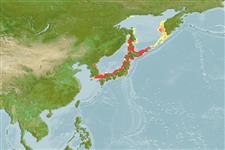>
Salmoniformes (Salmons) >
Salmonidae (Salmonids) > Salmoninae
Etymology: Oncorhynchus: Greek, onyx, -ychos = nail + Greek, rhyngchos = snout (Ref. 45335).
Environment: milieu / climate zone / depth range / distribution range
ນິເວດວິທະຍາ
ສັດທະເລ; ນ້ຳຈືດ; ນ້ຳກ່ອຍ ກ່ຽວກັບ (ຢູ່)ເທິງຊັ້ນພື້ນດິນໃນທະເລເປີດ; ປາທີ່ມີການເຄື່ອນຍ້າຍຈາກທະເລ ແລະ ໄປໄຂ່ຢູ່ນ້ຳຈືດ (Ref. 51243); ລະດັບຄວາມເລິກ 0 - 200 m (Ref. 50550). Temperate; 65°N - 34°N, 127°E - 158°E
Northwest Pacific: Japan and adjacent waters.
ຂະໜາດ / ນ້ຳໜັກ / Age
Maturity: Lm ? range ? - ? cm
Max length : 79.0 cm TL ຕົວຜູ້/ບໍ່ມີເພດ; (Ref. 56527); ນ້ຳໜັກສູງສຸດທີ່ເຄຍຈັດພີມມາ: 10.0 kg (Ref. 9988)
The fluviatile form generally inhabits headwaters and often maintains a territory; it feeds mainly on insects but also on small crustaceans and fishes. The sea-run form goes downstream forming schools, and after a short stay in the brackish zone enters the sea where it feeds on small fishes and pelagic crustaceans. Oviparous (Ref. 205). Eggs are buried in unguarded nests (Ref. 205). Marketed fresh and frozen; eaten broiled and baked (Ref. 9988).
Distinct pairing (Ref. 205). Reproductive strategy: synchronous ovarian organization, determinate fecundity (Ref. 51846).
Masuda, H., K. Amaoka, C. Araga, T. Uyeno and T. Yoshino, 1984. The fishes of the Japanese Archipelago. Vol. 1. Tokai University Press, Tokyo, Japan. 437 p. (text). (Ref. 559)
IUCN Red List Status (Ref. 130435)
Endangered (A1ac; B2abcde+3abd); Date assessed: 01 August 1996
Threat to humans
Harmless
Human uses
ການປະມົງ: ເປັນສີນຄ້າ; ການລ້ຽງສັດນ້ຳ: ເປັນສີນຄ້າ; ຊະນິດປາທີ່ຖືກນຳໃຊ້ເຂົ້າໃນການຫາເພື່ອເປັນເກມກິລາ: ແມ່ນ
ຂໍ້ມູນຕື່ມອີກ
ຜູ້ຮ່ວມມືຮູບStamps, Coins Misc.ສຽງຫອຍມີພິດຊະນິດນຶ່ງທີ່ອາໄສໃນທະເລຄວາມໄວປະເພດການລອຍເນື້ອທີ່ເຫືອກOtolithsສະໝອງວິໄສທັດ
ເຄື່ອງມື
Special reports
Download XML
ແຫຼ່ງອີນເຕີເນັດ
Estimates based on models
Preferred temperature (Ref.
123201): 0.3 - 16.5, mean 3.3 °C (based on 86 cells).
Phylogenetic diversity index (Ref.
82804): PD
50 = 0.5000 [Uniqueness, from 0.5 = low to 2.0 = high].
Bayesian length-weight: a=0.00955 (0.00605 - 0.01506), b=3.03 (2.90 - 3.16), in cm total length, based on LWR estimates for this species & Genus-body shape (Ref.
93245).
ຊັ້ນເຂດຮ້ອນ (Ref.
69278): 3.6 ±0.59 se; based on food items.
ຄວາມຢືດຢຸ່ນ (Ref.
120179): ຂະໜາດກາງ, ປະຊາກອນຕຳ່ສຸດທີ່ໃຊ້ເວລາສອງເທົ່າ 1.4 - 4.4 ປີ (tm=4; tmax=6; Fec=1,000).
Fishing Vulnerability (Ref.
59153): Moderate to high vulnerability (52 of 100).
Climate Vulnerability (Ref.
125649): Moderate to high vulnerability (49 of 100).
Nutrients (Ref.
124155): Calcium = 14.3 [4.9, 37.9] mg/100g; Iron = 0.265 [0.131, 0.597] mg/100g; Protein = 18.2 [17.0, 19.3] %; Omega3 = 1.64 [0.75, 3.60] g/100g; Selenium = 98.8 [29.8, 308.1] μg/100g; VitaminA = 14.2 [4.6, 42.8] μg/100g; Zinc = 0.545 [0.335, 1.074] mg/100g (wet weight);
